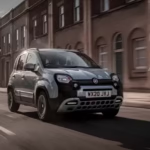
In a world where crossovers dominate and electrification is the order of the day, the mere idea of a bold, V8-powered American coupe feels like a rebellious throwback to a bygone era. But thanks to the artistry of digital renderers and enthusiasts, the 2026 Ford Thunderbird has been imagined anew—a sleek, powerful vision of what could be if nostalgia, design excellence, and performance were prioritised over practicality.
This digital revival of the Thunderbird, brought to life by rendering artist vburlapp, has stirred the imagination of gearheads and Ford fans alike, delivering a stunning blend of modern flair and classic soul.
The 2026 Thunderbird rendering showcases a vehicle that could easily be mistaken for a coachbuilt exotic. It echoes design language typically seen in Italian grand tourers, channeling Ferrari Portofino and California vibes with a wide, low-slung body, dramatic lines, and round twin taillights that harken back to the model’s 2001–2005 iteration. It’s muscular yet refined—an aesthetic cocktail of American muscle and European grace.
And while this rendering is purely speculative, it’s hard not to admire the idea: a Ford coupe that puts design first, leaning into the retro-futuristic cues that made the original Thunderbird such a hit in the 1950s and 60s.
The last official Thunderbird, produced between 2001 and 2005, was the eleventh generation of the nameplate. Built in Michigan at the Wixom Assembly Plant, it was a front-engine, rear-wheel drive cruiser riding on a platform shared with the Jaguar S-Type and Lincoln LS. Under the hood was a 3.9L Jaguar V8 pushing out 252 horsepower and 267 lb-ft of torque, paired with a five-speed automatic gearbox.
While not a performance powerhouse, that generation attempted to recapture the personal luxury coupe formula of earlier Thunderbirds. However, it never quite hit the mark with enthusiasts, partly due to its soft driving dynamics and retro styling that didn’t age gracefully.
If Ford were to actually bring back the Thunderbird, what would the perfect formula look like?
Many would argue it starts with a proper V8 heart—perhaps a supercharged 5.0L Coyote engine capable of rivaling the best from Dodge and Chevrolet. Imagine a road-legal dragster bearing the Thunderbird name, built to take on the now-discontinued Dodge Challenger SRT Demon 170, with four-digit horsepower figures and a guttural exhaust note that shakes your spine.
To keep costs under control, Ford could utilise the S650 Mustang platform as a base—giving the Thunderbird the bones of a proven performer, but wrapping it in a body that’s more refined, elegant, and exclusive. Think of it as a “luxury muscle coupe,” an upscale sibling to the Mustang rather than a direct rival.
The rendering by vburlapp does more than just honour the Thunderbird legacy—it elevates it. The long bonnet, wide rear haunches, and sculpted silhouette suggest a car that means business. The dual circular taillights are a direct nod to the past, while the aggressive grille and modern LED headlamps bring it firmly into the 2020s.
It’s a design that could easily compete with the likes of the Lexus LC500, or even more exotic offerings from Maserati and Aston Martin, especially if Ford were to take the leap into premium interiors and bespoke detailing.
Despite all the excitement, there’s a harsh dose of reality to consider. Ford, like most automakers, is deeply committed to electrification and SUVs. The company has poured billions into EVs like the Mustang Mach-E and the upcoming electric Explorer, and is unlikely to invest heavily in niche performance coupes with limited commercial appeal.
A project like this—nostalgic, expensive, and relatively impractical—doesn’t align with Ford’s current product strategy. The Thunderbird, for now, remains a digital dream.
While it may only exist in the pixels of a talented designer’s imagination, the 2026 Ford Thunderbird rendering offers a tantalising glimpse at what could have been if the Blue Oval leaned into its muscle car heritage just a little more. A V8-powered, rear-wheel drive grand tourer wearing the Thunderbird badge could have been the perfect modern expression of American motoring passion.
We may never see this car reach production, but for fans of the brand and automotive romantics, it’s a beautiful daydream—one that challenges the status quo and dares to ask: what if?





